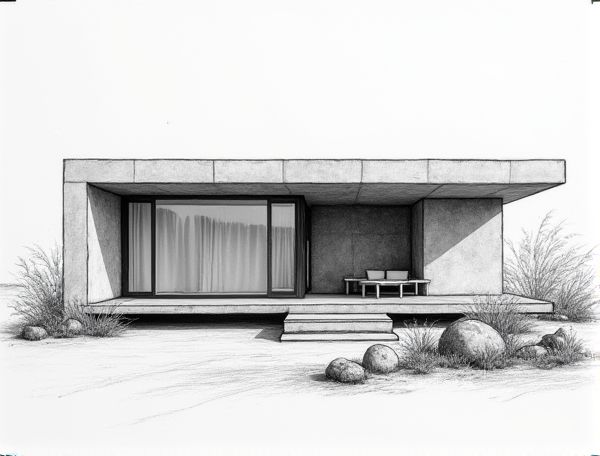
Photo illustration: Japandi home design with board-formed concrete
Japandi home design seamlessly blends Japanese minimalism with Scandinavian functionality, using board-formed concrete to create textured, natural accents that enhance Your living space's tranquility and modern aesthetic. Discover how incorporating this unique material elevates the balance of warmth and simplicity in the full article.
Introduction to Japandi Home Design
Japandi home design blends the minimalist aesthetics of Japanese interiors with the cozy warmth of Scandinavian style, creating a serene and functional living space. Your home benefits from natural materials, neutral tones, and clean lines that emphasize simplicity and harmony, promoting a calm and clutter-free environment.
The Essence of Board-Formed Concrete
Board-formed concrete captures the natural texture and grain of wooden boards, creating a distinctive, tactile surface that adds depth and character to modern architecture. This technique emphasizes raw, structural aesthetics, blending durability with artistic expression, making it ideal for accent walls, facades, and landscape features. Its use enhances spatial warmth and organic appeal while maintaining the strength and longevity of concrete.
Merging Japanese and Scandinavian Elements
Merging Japanese and Scandinavian design elements creates a harmonious blend of minimalist aesthetics and natural materials that emphasize simplicity and functionality. You can incorporate clean lines, neutral color palettes, and organic textures such as bamboo, light wood, and stone to create a serene living space. Integrating shoji screens with Scandinavian-style furniture enhances the balance between openness and privacy, fostering a tranquil atmosphere in your home.
Benefits of Board-Formed Concrete in Japandi Interiors
Board-formed concrete enhances Japandi interiors by introducing natural wood grain textures that complement the style's minimalist and organic aesthetic. Its durability and thermal mass improve energy efficiency while creating a warm, tactile contrast to sleek Japandi furnishings.
Minimalism Meets Texture: Design Principles
Minimalism in home design emphasizes clean lines, open spaces, and a monochromatic color palette to create a serene environment. Incorporating texture through natural materials like wood, stone, and woven fabrics adds depth and tactile interest without cluttering the space. Strategic layering of textured elements enhances visual appeal while maintaining the minimalist aesthetic, fostering a balanced and inviting atmosphere.
Color Palettes for Japandi Concrete Spaces
Japandi concrete spaces feature muted color palettes combining soft neutrals like beige, warm grays, and creamy whites with natural wood tones to evoke calmness and simplicity. Incorporating subtle earthy hues such as olive green and charcoal complements the raw texture of concrete, enhancing the minimalist aesthetic. Accents in matte black or deep navy provide visual interest while maintaining the serene, balanced atmosphere characteristic of Japandi design.
Furniture and Decor Selection
Carefully selecting furniture and decor enhances your home's aesthetic and functional appeal by combining style, comfort, and durability. Prioritize pieces that reflect your personal taste while complementing room dimensions and lighting to create a harmonious living space.
Achieving Warmth with Natural Materials
Incorporating natural materials such as wood, stone, and bamboo enhances your home's warmth and invites a cozy, inviting atmosphere. These elements not only improve aesthetic appeal but also contribute to sustainability and durability in design. Choosing textures and tones that resonate with natural light amplifies the sense of comfort and organic connection within your living space.
Lighting Strategies for Concrete Japandi Homes
Integrating layered lighting techniques such as recessed downlights, wall sconces, and pendant fixtures enhances the minimalist aesthetic and natural textures of concrete Japandi homes. Utilizing warm LED tones paired with dimmable options emphasizes the organic materials while creating a cozy, balanced ambiance essential to Japandi design principles.
Maintenance and Sustainability Considerations
Incorporating durable materials and energy-efficient systems reduces long-term maintenance costs and enhances your home's sustainability. Prioritizing water-saving fixtures and renewable energy options ensures environmental responsibility while maintaining comfort and functionality.
 homedesy.com
homedesy.com